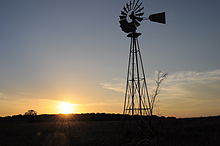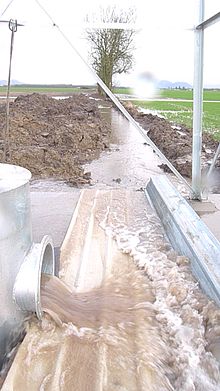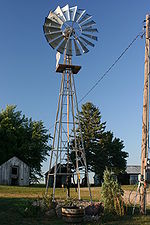- Windpump
-
A windpump is a windmill used for pumping water, either as a source of fresh water from wells, or for draining low-lying areas of land. Once a common fixture on farms in semi-arid areas, windpumps are still used today where electric power is not available or too expensive.
Contents
History
 Wind powered water pump on Oak Park Farm, Shedd, Oregon. This pump is used to drain excess water from farm land to improve agricultural production. It operates a 28 inch diameter piston pump with a 16 inch stroke. It pumps 360 gallons per minute on an average windy day. This is the first large wind-powered agricultural pump in the U.S. and is a good example of modern technology being applied to an old, well-proven technology.
Wind powered water pump on Oak Park Farm, Shedd, Oregon. This pump is used to drain excess water from farm land to improve agricultural production. It operates a 28 inch diameter piston pump with a 16 inch stroke. It pumps 360 gallons per minute on an average windy day. This is the first large wind-powered agricultural pump in the U.S. and is a good example of modern technology being applied to an old, well-proven technology.
Windmills were used to pump water since at least the 9th century in what is now Afghanistan, Iran and Pakistan.[1] The use of windmills became widespread across the Muslim world and later spread to China and India as well.[2] Windmills were later used extensively in Europe, particularly in the Netherlands and the East Anglia area of Great Britain, from the late Middle Ages onwards, to drain land for agricultural or building purposes. Early immigrants to the New World brought with them the technology of windmills from Europe.[3]
On US farms, particularly in the Midwest, windpumps were used to pump water from farm wells for cattle. The self-regulating farm wind pump was invented by Daniel Halladay in 1854.[3][4][5] Eventually steel blades and steel towers replaced wooden construction, and at their peak in 1930, an estimated 600,000 units were in use, with capacity equivalent to 150 megawatts.[6] Early wind pumps directly operated the pump shaft from a crank attached to the rotor of the windmill; the installation of back gearing between wind rotor and pump crank allowed the pump to function at lower wind speeds.
The multi-bladed wind turbine atop a lattice tower made of wood or steel hence became, for many years, a fixture of the landscape throughout rural America. These mills, made by a variety of manufacturers, featured a large number of blades so that they would turn slowly with considerable torque in low winds and be self regulating in high winds. A tower-top gearbox and crankshaft converted the rotary motion into reciprocating strokes carried downward through a rod to the pump cylinder below. Rising energy costs and improved pumping technology are increasing interest in the use of this once declining technology.
Worldwide use
Windpumps are used extensively in Southern Africa, Australia, on farms and ranches in the central plains and South West of the United States. In South Africa and Namibia thousands of windpumps are still operating. These are mostly used to provide water for human use as well as drinking water for large sheep stocks.
Kenya has also benefited from the African development of windpump technologies. At the end of the 1970s, the UK NGO Intermediate Technology Development Group provided engineering support to the Kenyan company Bobs Harries Engineering Ltd for the development of the Kijito windpumps. Bobs Harries Engineering Ltd is still manufacturing the Kijito windpumps, and more than 300 Kijito windpumps are operating in the whole of East Africa.
The Netherlands is well known for its windmills. Most of these iconic structures situated along the edge of polders are actually windpumps, designed to drain the land. These are particularly important as much of the country lies below sea level.
Eight to ten-bladed windmills were used in the Region of Murcia, Spain to raise water for irrigation purposes.[7] The drive from the windmill's rotor was led down through the tower and back out through the wall to turn a large wheel known as a noria. The noria supported a bucket chain which dangled down into the well. The buckets were traditionally made of wood or clay. These windmills were still in use until the 1950s, and many of the towers are still standing.
In the UK, the term windpump is seldom used and they are better known as Drainage windmills. Many of these were built in The Broads and The Fens, of East Anglia for the draining of land, but most of them have since been replaced by diesel or electric powered pumps. Many of the original windmills still stand in a derelict state (pictured), although some have been restored.
In many parts of the world a Rope pump is being used in conjunction with wind turbines. This easy to construct pump works by pulling a knotted rope through a pipe (usually a simple PVC pipe) Causing the water to be pulled up into the pipe. It has become common in Nicaragua and other places.
Construction
To construct a windpump, the bladed rotor needs to be matched to the pump. With non-electric windpumps, high solidity rotors are best used in conjunction with positive displacement (piston) pumps, because, single-acting piston pumps need about three times as much torque to start them as to keep them going. Low solidity rotors, on the other hand, are best used with centrifugal pumps, waterladder pumps and chain and washer pumps, where the torque needed by the pump for starting is less than that needed for running at design speed. Low solidity rotors are best used if they are intended to drive a electricity generator; which in turn can drive the pump.[8]
Windpump types
Multi-bladed windpumps
"American", multi-bladed wind pumps, can be found worldwide and are manufactured in the United States, Argentina, China, New Zealand, and South Africa. A 16 ft (4.8 m) diameter wind pump can lift up to 1600 US gallons (about 6.4 metric tons) of water per hour an elevation of 100 ft with a 15 to 20 mph wind (24–32 km/h),[9] according to a modern manufacturer. A properly designed Wind pump begins working in a 3-4 mph (5 to 6.5 km/h) wind. Wind pumps require little maintenance, only a change of gear box oil annually.[10] An estimated 60,000 wind pumps are still in use in the United States. They are particularly attractive for use at remote sites where electric power is not available and maintenance is difficult to provide.
General efficiency
Although the efficiency of a windpump is dependant on the type of bladed rotor and pump used, some general figures regarding its efficiency can be given. In general, a windpump is around 7% efficient for a common, home / local built wind pump and up to 30% efficient for a well designed and constructed factory made wind pump.
Combinations
Tjasker
In the Netherlands, the tjasker is a popular drainage wind pump with common sails connected to the Archimedean screw. This was used for raising water in areas where only a small lift of water was required. The windshaft sat on a tripod which allowed it to pivot. The archimedean screw raised water into a collecting ring, where it was drawn off into a ditch at a higher level, thus draining the land.[11]
Thai windpumps
In Thailand, windpumps were made on Chinese windpump designs. They were constructed from wire-braced bamboo poles carrying fabric sails; a paddle pump or waterladder pump is fixed to a Thai bladed rotor. The water lift was typically less than 1 meter.
See also
- Tjasker on Dutch Wikipedia
- Wind turbine
- Coil pump, another frequently used pump[12]
- Loeriesfontein, Northern Cape, where there is a museum dedicated to water pumping windmills
References
- ^ Lucas, Adam (2006), Wind, Water, Work: Ancient and Medieval Milling Technology, Brill Publishers, p. 65, ISBN 9004146490
- ^ Donald Routledge Hill, "Mechanical Engineering in the Medieval Near East", Scientific American, May 1991, p. 64-69. (cf. Donald Routledge Hill, Mechanical Engineering)
- ^ a b "Brief History of Windmills in the New World"
- ^ americanheritage.com
- ^ fnal.gov
- ^ Paul Gipe, Wind Energy Comes of Age, John Wiley and Sons, 1995 ISBN 0-471-10924-X, pages 123-127
- ^ http://www.yachtmollymawk.com/2008/11/spanish-water-works/ Water-lifting mills in the Region of Murcia, Spain
- ^ Water lifting devices; matching bladed rotors to pumps
- ^ Iron Man Windmill Website pumping capacity calculator, retrieved January, 15 2011
- ^ Aermotor Web site frequently asked questions, retrieved Sept. 17, 2008
- ^ "The types of windmills". Odur. http://odur.let.rug.nl/polders/boekje/types.htm. Retrieved 2008-05-24.
- ^ Coil pump frequently used for windpump construction
External links
Categories:- Windpumps
- Sustainable technologies
- Wind power
- Energy harvesting
- Windmills
Wikimedia Foundation. 2010.




